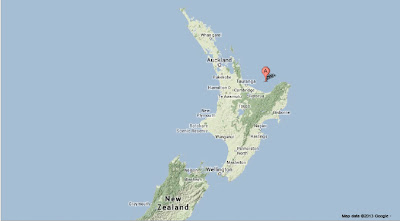White Island, or Te Puia o Whakaari, an island volcano in New Zealand's Bay of Plenty, began to erupt suddenly at about 10.20 am local time on Monday 20 August 2013, producing a 2 km high column of gas and steam in an eruption that lasted about 10 minutes. While the volcano has been intermittently active since 2000, there was no immediate sign that it was about to erupt in this way, though Nico Fournier, a volcanologist with GeoNet, the New Zealand body that monitors geological hazards, has observed that it was not completely unexpected either, the volcano having erupted in this way in the past. The column does not appear to have had any significant ash content, and dispersed within a few minutes. Tourist trips to the island have been temporarily suspended.
Steam column issuing from White Island on 20 August 2013. Jennifer & Alex Simon/TVNZ.
White Island is the tip of a submerged stratovolcano (cone-shaped volcano made up of successive lavers of ash and lava), reaching 321 m above sea-level and measuring 2 × 2.4 km. The volcano is highly active, having erupted numerous times since written records began in 1826, and with more eruptions mentioned in Maori oral traditions (the name Te Puia o Whakaari means 'The Dramatic Volcano'. The island is uninhabited, due to its small size and the presence of an active volcano (an attempt to mine sulphur on the island ended in disaster in 1914, when an eruption triggered a lahar - sudden flow of water, mud and ash - that killed all ten miners).
The volcanoes of New Zealand are fed by the subduction of the Pacific Plate beneath the Islands, which sit on the eastern margins of the Australian Plate. As the Pacific Plate sinks into the Earth, a combination of heat from the friction and from the planet's interior partially melts the plate, and some of the melted material rises through the overlying Australian Plate, supplying the volcanoes of New Zealand with liquid magma.
The approximate location of White Island. Google Maps.
See also Magnitude 6.6 Earthquake and series of aftershocks hit South Island, New Zealand, New Zealand rattled by Earthquakes, Pumice raft linked to Havre Seamount, not Monowai, Pumice raft suggests eruption from Mount Monowai and Volcanic activity on White Island, New Zealand.
Follow Sciency Thoughts on Facebook.


